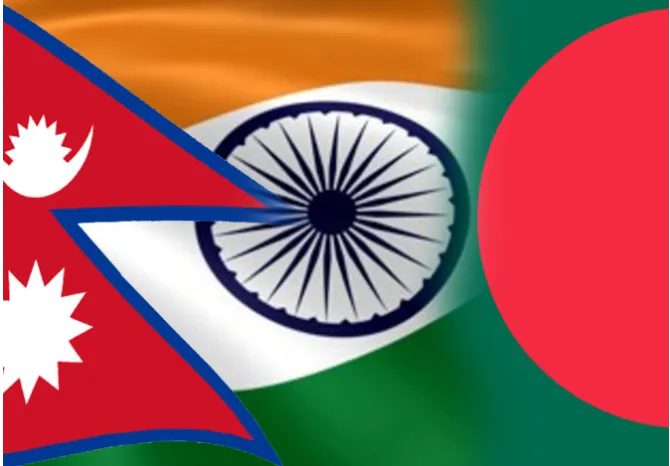-
CENTRES
Progammes & Centres
Location
The Nepal-India-Bangladesh (NIB) energy trade is only the tip of the iceberg. The true potential of the NIB region can be realised through the creation of the NIB economic corridor.

The ushering of 2024 marks the two-day visit of India’s External Affairs Minister, S. Jaishankar, to Nepal for a high-level joint commission meeting of foreign ministers. One of the highlights of the visit will be discussions about the sale of 10,000 MW of power by Nepal to India and subsequently wheeling out the sale of Nepali hydropower to Bangladesh through India. This will give the Nepal-India-Bangladesh (NIB) energy trade a definite head-start. However, the energy trade is only the tip of the iceberg in terms of the massive potential that lies latent in the NIB region—a potential that can only be realised through economic cooperation and more significantly through the creation of the NIB economic corridor. While South Asia has a population close to 1.8 billion, formal intra-region trade and investments have been dismally low. The South Asian Association for Regional Cooperation (SAARC) has remained in hibernation with no meetings held since 2014. The South Asian Free Trade Agreement (SAFTA) signed with much fanfare in 2004 has also remained an arrangement on paper. While the problems in the SAARC led many to think that the alternate BIMSTEC framework might be a workable solution, it does not exhibit much promise on the trade front. The BIMSTEC intra-regional trade was as low as 10 percent of that of a comparable regional framework like the ASEAN in 2021. On the other hand, the Bangladesh, Bhutan, India and Nepal (BBIN) regional initiative commenced with the signing of the Motor Vehicle Agreement (MVA) in June 2015. However, under the BBIN MVA, Bhutan has expressed reservations about granting unlimited access to its roads for vehicles due to potential environmental impacts. Not much has moved since the last meeting on the protocols in March 2022. While many thought that the BBIN MVA could pave the way for a broader regional economic cooperation with the creation of the BBIN economic corridor, the limbo with the MVA has set several questions against such thinking. In that case, why not propose the alternative NIB (Nepal, India and Bangladesh) economic corridor?
The BIMSTEC intra-regional trade was as low as 10 percent of that of a comparable regional framework like the ASEAN in 2021.
While trade of agricultural produce and manufacturing based on local resources is happening informally and warrants an incentivised move to formal trade, the major economic potential lies in tourism. The NIB corridor comprising Nepal, Eastern and Northeastern India and Bangladesh provides a market of over 400 million people. Regarding the four-capital taxonomy, which includes physical, human, natural, and social capital, the NIB region, except physical capital, is abundant in the remaining three. The region's vast mineral resources, forests, and river basins constitute a significant natural capital foundation. For instance, mountains, which cover a substantial area of the NIB region, are a crucial source of ecosystem services. This highlights the need for institutional cooperation to capitalize on these resources sustainably. Additionally, the extensive natural capital of river basins, significant deposits of metals and minerals, and forests present an opportunity for a natural comparative advantage in the global market for nature-based commodities, although these advantages remain largely untapped. Certain conservative estimates of the values of ecosystem services suggest that in South Asia, the human community obtains more value (to the extent of 25 percent more) from the ecosystem than from the incomes through formal and informal economic engagements.
In terms of human capital, Nepal, Eastern, and North-Eastern India, and Bangladesh offer an abundant and cost-effective workforce. Meanwhile, Western India and its neighbouring economies have been driven by low labor costs, increasing consumption rates, urbanization, and a focus on manufacturing and agriculture. Just prior to the COVID, Bangladesh emerged as a hub for IT freelancing, boasting a community of 600,000 freelancers. The NIB region is characterized by a predominantly young population, ambitious and forward-looking, with little connection to the colonial past. This demographic is set to influence the political landscape in the future. For example, since 2018, India's working-age population has outnumbered its dependent population. This demographic dividend is expected to last until 2055—a 37-year span. Similarly, 65 percent of Nepal’s population belongs to the working age group of 15-64 years, with around 59 percent of the population below 30 years and a shrinking but sizeable 29 percent of the population still under the age of 15. This shift in population structure can lead to rapid growth, provided there are strong social indicators such as quality education, healthcare, and decent employment opportunities.
The NIB region is characterized by a predominantly young population, ambitious and forward-looking, with little connection to the colonial past.
Finally, digitalisation and globalisation are shrinking the world. While everything from one country is available in another country informally, the challenge lies in formalising such trade. E-commerce portals offer avenues for seafood from Bangladesh to find ways to eastern India and Nepal, just as high-end high-value cheese produced in Kathmandu can find its way to the high-income groups in Dhaka. Digital platforms are easing payments and collection of taxes, thereby improving accessibility and transparency. Logistic companies have evolved to be in the business of providing services rather than becoming agents to collect and pay bribes at the borders.
At the same time, the idea will be to use India’s growing economic relations with the Middle East, the European Union, the United States (US) and Australia that provide a potent product market for the NIB’s vibrant factor market rendered through its competitiveness in human and natural capital. All the NIB needs to do is to develop its physical capital—this is where a large economy like India needs to provide the leadership.
Border trade and transit have been made easier as goods from one country can find a market in another while being transported through another country.
One of the successful models of economic cooperation amongst developing countries has been the East Africa Community (EAC). An EAC visa gives access to Kenya, Rwanda, and Uganda on single visa, which is reflected in increased regional trade and movement of people. Border trade and transit have been made easier as goods from one country can find a market in another while being transported through another country. Looking at these cross-border opportunities, companies like Dubai-based DP World are setting up logistic hubs. Rusumo Hydropower Project has been developed jointly by Rwanda, Burundi and Tanzania for consumption in all three countries. EAC offers a replicable model for South Asia and especially for NIB to learn from. The objective of the NIB economic corridor will be to remove the trade barriers, create enabling business conditions, diminish the transaction costs of doing business internally, and most importantly, create a vibrant factor market to cater to the needs of the growing product markets of the emerging economies and the developed world as discussed earlier.
The 2023 World Trade Report by WTO envisages an era of re-globalization where globalization will emerge in a new avatar through regional cooperation. NIB economic corridor has the potential to be the epitome of that proposed model.
Nilanjan Ghosh is Director, CNED and ORF Kolkata, Observer Research Foundation.
Sujeev Shakya is Chair of the Nepal Economic Forum.
The views expressed above belong to the author(s). ORF research and analyses now available on Telegram! Click here to access our curated content — blogs, longforms and interviews.

Dr Nilanjan Ghosh heads Development Studies at the Observer Research Foundation (ORF) and is the operational head of ORF’s Kolkata Centre. His career spans over ...
Read More +
Sujeev Shakya is the Chair of the Nepal Economic Forum and a Senior Fellow at the National University of Singapore Institute of South Asian Studies ...
Read More +